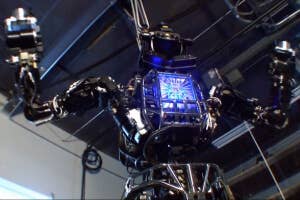Boston Dynamics’ Humanoid Robot, ATLAS, In Latest Video

Share
Boston Dynamics, the robotics design company, has been demonstrating to the world that we're knee deep in the robot revolution. It was only back in April when the company released a series of videos of the humanoid robot PETMAN, which captured a lot of media attention and a mix of reactions across the web.
Now only a few short months later, the latest design from Boston Dynamics dubbed the ATLAS robot has been unveiled as part of the DARPA Robotics Challenge Trials, which is the next stage in a grand challenge sequence. ATLAS is a 6 foot 2 inch, 330-lb robot outfitted with hydraulic actuated joints, LIDAR sensing head, an onboard control computer, thermal management (like the PETMAN), and two sets of hands designed by iRobot and Sandia National Labs.
The released video is both awesome and unnerving in how life-like the company's robots are becoming:
One thing is clear: ATLAS looks human because it's designed to do what humans do...in certain situations, that is.
Before anyone freaks out about what science fiction movies have repeatedly forewarned us about, DARPA's goal with this program is aimed at generating robots that can "perform the most hazardous activities in future disaster response operations." The seven teams selected to progress from the Virtual Robotics Challenge in June are tasked with programming ATLAS to carry out functions appropriate to the disaster scenario. The finals and a $2 million prize for DARPA's challenge are schedule for the end of 2014.
Be Part of the Future
Sign up to receive top stories about groundbreaking technologies and visionary thinkers from SingularityHub.


Putting machines in places that are highly dangerous to humans is nothing new, but advances in AI and robotics has raised their sophistication to seemingly autonomous levels. This same phenomenon is occurring with the use of drones, as the military increasingly uses them as the go-to solution for operations that could cost soldiers their lives. Though concerns of privacy and security abound, the motive behind these development in robotics is to keep people from physical harm, regardless of the situation.
To learn more about the teams in the competition, check out the following video:
David started writing for Singularity Hub in 2011 and served as editor-in-chief of the site from 2014 to 2017 and SU vice president of faculty, content, and curriculum from 2017 to 2019. His interests cover digital education, publishing, and media, but he'll always be a chemist at heart.
Related Articles

These Robots Are the Size of Single Cells and Cost Just a Penny Apiece

Hugging Face Says AI Models With Reasoning Use 30x More Energy on Average

Study: AI Chatbots Choose Friends Just Like Humans Do
What we’re reading